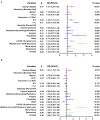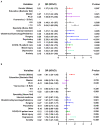The impact of the COVID-19 pandemic on the prevalence and risk factors of workplace violence among healthcare workers in China
- PMID: 35958846
- PMCID: PMC9358256
- DOI: 10.3389/fpubh.2022.938423
The impact of the COVID-19 pandemic on the prevalence and risk factors of workplace violence among healthcare workers in China
Abstract
Background: The pandemic of COVID-19 has significantly increased the burden on healthcare workers and potentially affect their risk of workplace violence (WPV). This study aimed to explore the prevalence and risk factors of WPV among healthcare workers during the peaking and the remission of the COVID-19 pandemic in China.
Methods: Using the snowball method, a repeated online questionnaire survey was conducted among Chinese healthcare workers from March 27th to April 26th in 2020 and 2021, respectively. Data included healthcare workers' socio-demographic and occupational characteristics, psychological status, and workplace violence.
Results: A total of 3006 samples in 2020 and 3465 samples in 2021 were analyzed. In 2020, the prevalence of WPV and witnessing colleagues suffering from WPV among healthcare workers were 64.2% and 79.7% respectively. Compared with 2020, the prevalence decreased by 11.0% and 14.4% in 2021, respectively. Logistic regression showed that WPV in 2020 was influenced by males, long working experience, working in the psychiatric department, direct contact with COVID-19 patients, self-discovery of medical errors, moral injury, depression, and anxiety (minimum OR = 1.22, maximum OR = 2.82). While risk factors of WPV in 2021 included males, working in psychiatric departments, self-discovery of medical errors, moral injury, depression, and anxiety (minimum OR = 1.33, maximum OR = 3.32); and protective factors were holding a master's degree (OR = 0.78) and working in other departments (OR = 0.54).
Conclusion: This study retains the common effects of WPV among healthcare workers, though after the baptism of the COVID-19 pandemic, the prevalence of WPV among healthcare workers decreased; however, part of the influencing factors changed. In addition, COVID-19 has seriously affected the mental health of healthcare workers, and the effect of mental health problems on WPV should also attract more attention.
Keywords: COVID-19; China; healthcare workers; prevalence; risk factors; workplace violence.
Copyright © 2022 Qi, Hu, Liu, Wen, Hu, Wang and Shi.
Figures


Similar articles
-
Workplace violence against healthcare workers during the COVID-19 pandemic: a systematic review and meta-analysis.Environ Sci Pollut Res Int. 2023 Jun;30(30):74838-74852. doi: 10.1007/s11356-023-27317-2. Epub 2023 May 20. Environ Sci Pollut Res Int. 2023. PMID: 37209334 Free PMC article.
-
Workplace Violence against Hospital Workers during the COVID-19 Pandemic in Israel: Implications for Public Health.Int J Environ Res Public Health. 2022 Apr 12;19(8):4659. doi: 10.3390/ijerph19084659. Int J Environ Res Public Health. 2022. PMID: 35457525 Free PMC article.
-
Violence against healthcare workers during the COVID-19 pandemic: a cross-sectional study from Egypt.Arch Environ Occup Health. 2022;77(8):621-627. doi: 10.1080/19338244.2021.1982854. Epub 2021 Sep 30. Arch Environ Occup Health. 2022. PMID: 34590540
-
Workplace violence against COVID-19 front-line healthcare workers versus non-front-line in Hangzhou, China: a cross-sectional study.BMJ Open. 2023 Sep 29;13(9):e073226. doi: 10.1136/bmjopen-2023-073226. BMJ Open. 2023. PMID: 37775296 Free PMC article.
-
Workplace violence against health care workers during the COVID-19 Pandemic: A systematic review and meta-analysis.J Safety Res. 2023 Jun;85:1-7. doi: 10.1016/j.jsr.2023.01.001. Epub 2023 Jan 24. J Safety Res. 2023. PMID: 37330859 Free PMC article.
Cited by
-
Standardized training nurses's humanistic care practice ability: A cross-sectional survey in western China during COVID-19.Nurs Open. 2024 Mar;11(3):e2123. doi: 10.1002/nop2.2123. Nurs Open. 2024. PMID: 38429899 Free PMC article.
-
Workplace aggression against healthcare workers in a Spanish healthcare institution between 2019 and 2021: The impact of the COVID-19 pandemic.Front Public Health. 2023 Mar 22;11:1070171. doi: 10.3389/fpubh.2023.1070171. eCollection 2023. Front Public Health. 2023. PMID: 37033051 Free PMC article.
-
Job security among healthcare workers in Guangdong, China.Front Public Health. 2023 Mar 1;11:1096825. doi: 10.3389/fpubh.2023.1096825. eCollection 2023. Front Public Health. 2023. PMID: 36935715 Free PMC article.
-
Prevalence and predictors of workplace violence against emergency physicians in China: a cross-sectional study.Hum Resour Health. 2023 Feb 8;21(1):8. doi: 10.1186/s12960-022-00784-3. Hum Resour Health. 2023. PMID: 36755287 Free PMC article.
-
Roles of doctor-patient relationship perception and job satisfaction in the impact of workplace violence on medical professionals' turnover intentions in the early phase of COVID-19: a cross-sectional study in China.BMJ Open. 2023 Sep 4;13(9):e074744. doi: 10.1136/bmjopen-2023-074744. BMJ Open. 2023. PMID: 37666559 Free PMC article.
References
-
- Chappell D, Martino VD. Violence at Work, 3rd ed. Geneva: International Labour Office; (2006).
-
- Occupational Safety Health Administration . Workplace Violence. (2021). Available online at: https://www.osha.gov/workplace-violence (accessed April 25, 2022).
Publication types
MeSH terms
LinkOut - more resources
Full Text Sources
Medical
Miscellaneous

